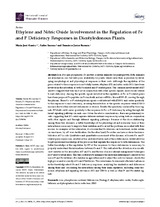Ethylene and Nitric Oxide Involvement in the Regulation of Fe and P Deficiency Responses in Dicotyledonous Plants
Autor
García, María José
Lucena, Carlos
Romera, Francisco Javier
Editor
MDPIFecha
2021Materia
IronPhosphorous
Nutrient deficiencies
Strategy I
Ethylene
Nitric oxide
S-nitrosoglutathione
Acid phosphatase
Ferric reductase
EIN3
METS:
Mostrar el registro METSPREMIS:
Mostrar el registro PREMISMetadatos
Mostrar el registro completo del ítemResumen
Iron (Fe) and phosphorus (P) are two essential elements for plant growth. Both elements are abundant in soils but with poor availability for plants, which favor their acquisition by developing morphological and physiological responses in their roots. Although the regulation of the genes related to these responses is not totally known, ethylene (ET) and nitric oxide (NO) have been involved in the activation of both Fe-related and P-related genes. The common involvement of ET and NO suggests that they must act in conjunction with other specific signals, more closely related to each deficiency. Among the specific signals involved in the regulation of Fe- or P-related genes have been proposed Fe-peptides (or Fe ion itself) and microRNAs, like miR399 (P), moving through the phloem. These Fe- or P-related phloem signals could interact with ET/NO and confer specificity to the responses to each deficiency, avoiding the induction of the specific responses when ET/NO increase due to other nutrient deficiencies or stresses. Besides the specificity conferred by these signals, ET itself could confer specificity to the responses to Fe- or P-deficiency by acting through different signaling pathways in each case. Given the above considerations, there are preliminary results suggesting that ET could regulate different nutrient responses by acting both in conjunction with other signals and through different signaling pathways. Because of the close relationship among these two elements, a better knowledge of the physiological and molecular basis of their interaction is necessary to improve their nutrition and to avoid the problems associated with their misuse. As examples of this interaction, it is known that Fe chlorosis can be induced, under certain circumstances, by a P over- fertilization. On the other hand, Fe oxides can have a role in the immobilization of P in soils. Qualitative and quantitative assessment of the dynamic of known Fe- and P-related genes expression, selected ad hoc and involved in each of these deficiencies, would allow us to get a profound knowledge of the processes that regulate the responses to both deficiencies. The better knowledge of the regulation by ET of the responses to these deficiencies is necessary to properly understand the interactions between Fe and P. This will allow the obtention of more efficient varieties in the absorption of P and Fe, and the use of more rational management techniques for P and Fe fertilization. This will contribute to minimize the environmental impacts caused by the use of P and Fe fertilizers (Fe chelates) in agriculture and to adjust the costs for farmers, due to the high prices and/or scarcity of Fe and P fertilizers. This review aims to summarize the latest advances in the knowledge about Fe and P deficiency responses, analyzing the similarities and differences among them and considering the interactions among their main regulators, including some hormones (ethylene) and signaling substances (NO and GSNO) as well as other P- and Fe-related signals.

